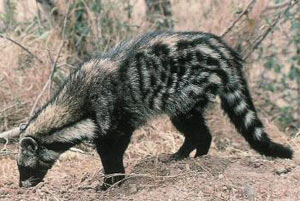Media Listens: “Oriental Yeti” = Civet?
Posted by: Loren Coleman on April 9th, 2010
It was an interesting week. Who would have ever imagined that talking about civets would cause the press to mix up my gender by Friday?
It appeared to start off wild enough, with mentions in the United Kingdom media of the story of the “Oriental Yeti.” Then I was interviewed by the Christian Science Monitor and AOL News, the same day. Those stories were rushed online, within hours. Before you knew it, the news was viral, on everything from Discovery News to KidGlue.



This activity happened concurrent to a Metro reporter picking up on my Cryptomundo blog’s explanation.
All the media who quoted me pointed to this “Yeti” probably being a civet with mange, as per me. That was good news, because the redefining of “Yeti” via this bit of news would have not been a good trend to see reinforced.
By week’s end, it all had come full circle, locationwise, as I was mentioned in Beijing Today, and Ben Radford noted my civet thoughts in his skeptically-oriented column.

Radford (above) threw in a twist no one else had, since his forthcoming “chupacabra” book may have been on his mind. Perhaps global warming was behind all these hairless, mangy animals, he asked.
Here are some of the other highlights from the week.

“This is not a true Yeti. This is more media madness,” says Loren Coleman, author of more than 30 books on mythical creatures, including Bigfoot! The True Story of Apes in America published by Simon and Schuster.” – April 6, 2010 – Christian Science Monitor, in an article by Stephen Kurczy (on the left above in the Himalayas), Correspondent / April 6, 2010
Kurczy’s captures what I said pretty well, with him only misquoting me when I told him that that this animal “sounding like a cat” probably was a clue to it being what some call a “civet cat” or more correctly, a “civet.” The story circulated around the world in over 50 outlets, and the cat bit was sometimes repeated. Generally, the “civet” identification was what was used, thank goodness:
If it sounds like a cat, then it probably is a cat, says Mr. Coleman, who opened the International Cryptozoology Museum in November in downtown Portland, Maine. The museum features hair samples and some 150 foot casts credited to Bigfoot, Sasquatch, and the yeti.
China’s so-called “Oriental Yeti” appears to be either an Asian palm or common civet (Paradoxurus hermaphroditus), or a masked or Himalayan palm civet (Paguma larvata), says Coleman, who spoke by phone today with the Monitor. The cat looks to have lost its hair because of a bad case of mange – the skin disease caused by parasitic mites. Similar-looking animals in the American southwest have come to be called chupacabras, a hairless quadruped that is likely no more than a dog or cat with mange.
In the past 60 years cryptozology – the study of mythical or legendary animals – has grown into somewhat reputable science, with several universities now offering courses in the subject. Coleman created one of the first, at the University of Southern Maine, where he taught in the zoology department for two decades.
“If the Asian press starts using the word ‘yeti’ for every unidentified animal it’s going to muddy the waters of cryptozoology,” Coleman says.
“Even though we haven’t found the yeti, we have a body of literature on the yeti going back 3,000 years,” he adds. The yeti of central Asia and the Sasquatch of the Pacific Northwest are an ape-like biped between 4 and 7 feet tall, and a version of it exists in many regions worldwide: China’s yeti is normally called the yeren; in Australia, it’s the yowie; in Malaysia, it’s the sejarang gigi; and in Brazil, they call it the mapinguari.
Coleman says the field of cryptozoology has grown from a handful of people into tens of thousands of followers, and he alone gets hundreds of emails daily from self-proclaimed cryptozoologists. Even chimpanzee researcher Jane Goodall says she is sure that undiscovered primates, such as the Yeti or Sasquatch, exist.
“When I’m asked do I believe in yeti or Bigfoot, I say ‘no,’ because belief is the realm of religion. I consider that there is good evidence for the yeti, enough for us to pursue it. But I’m not convinced it’s a folklore tradition or a zoological tradition.
“I occupy the skeptical, open-minded middle,” he continues. “The blind debunkers are just as dangerous as the true believers. I’m a skeptical, open-minded cryptozoologist.”
Tony Phillips wrote in the Metro:
Noted cryptozoologist Loren Coleman – an expert in investigating claims of mythical or otherwise unexplained beasts – suggests the answer is probably quite mundane. He says on his Cryptomundo blog that it’s almost certainly a civet suffering from mange (a disease that causes baldness).
Specifically, he suspects it’s either an Asian palm or common civet, or a masked or Himalayan palm civet. Pictures of these civets certainly do look plausibly like the animal above, but with fur.

AOL News reporter Michelle Ruiz (above) interviewed me and then came at the story from a slightly different angle, regarding the identification:
According to Loren Coleman, a cryptozoologist who has written 17 books on mysterious animals and legends like Bigfoot, the “oriental yeti” is not a yeti at all, but likely a kind of civet, a small carnivorous animal akin to the mongoose.
“My guess is this animal is either an Asian palm or Himalayan palm civet,” Coleman told AOL News. “It’s a kind of weasel-like animal that eats other small animals. Civets are really an animal all to themselves.”
As for the creature’s lack of fur, Coleman believes it has mange, a skin disease caused by mites.
“Mange sweeps through populations of small animals just like this one,” he said. “The scratches on the animal’s body are consistent with mange.”
Despite the hype surrounding the discovery of the animal, Coleman said he believes DNA tests will show the finding is “in no way anything extraordinary.”
By the 7th of April, the story had spread so widely, the mistake wasn’t in the business about the Yeti vs the civet, but in my gender. Here’s how the Toronto Sun had it:
Loren Coleman, who writes books about cryptozoology, the study of legendary animals considered non-existent by most biologists — like Bigfoot or the Loch Ness Monster — penned her theories about the oriental yeti on her blog, Cryptomundo.com.She said it’s not a yeti. Those are supposed to be bear-like and bigger than people.
“Hopefully, folks in Asia won’t start putting the moniker ‘Yeti’ on all their mangy critters now, too,” she wrote.
Coleman suggested it might be a civet of some sort — normally furry little mammals native to Asia and Africa.
Sometimes you are just glad to get out of these stories alive, and basically, I wasn’t misquoted too badly. Stepping away from the week that was, I think people were rather more realistically aware of the fact that mangy civets are much different than Yetis.
But then, on Friday, there was the London Free Press quoting that woman named Loren Coleman, one of the world’s leading cryptozoologists, about this Yeti=civet business. OMG.
So it goes; as to the confusion about what a “Loren Coleman” is, well, that mystery continues, unabated.
About Loren Coleman
Loren Coleman is one of the world’s leading cryptozoologists, some say “the” leading living cryptozoologist. Certainly, he is acknowledged as the current living American researcher and writer who has most popularized cryptozoology in the late 20th and early 21st centuries.
Starting his fieldwork and investigations in 1960, after traveling and trekking extensively in pursuit of cryptozoological mysteries, Coleman began writing to share his experiences in 1969. An honorary member of Ivan T. Sanderson’s Society for the Investigation of the Unexplained in the 1970s, Coleman has been bestowed with similar honorary memberships of the North Idaho College Cryptozoology Club in 1983, and in subsequent years, that of the British Columbia Scientific Cryptozoology Club, CryptoSafari International, and other international organizations. He was also a Life Member and Benefactor of the International Society of Cryptozoology (now-defunct).
Loren Coleman’s daily blog, as a member of the Cryptomundo Team, served as an ongoing avenue of communication for the ever-growing body of cryptozoo news from 2005 through 2013. He returned as an infrequent contributor beginning Halloween week of 2015.
Coleman is the founder in 2003, and current director of the International Cryptozoology Museum in Portland, Maine.










It’s interesting the number of cases of alleged cryptids over the last few years that have involved animals with mange.
Is the mange spreading and at a very high level amongst the animal population now, or has it always been the same over the centuries.
It makes you wonder, when looking at historical accounts of cryptids, just how many of them could have been just animals with a bad case of mange.
I’ve had the same question, but I think we have two different elements working here. Firstly, I personally believe that the coydog/chapacabra is a unique hairless breed that has given the media a convenient scapegoat and a new model for media “wipes” (which leads me to my second point). Because hairless animals look so different than what we are used to the media is promoting the mange stories as it gives them an easy out for “wiping” future cryptid stories. Suddenly every bigfoot is a mangy bear, and EVERYONE knows it.
Considering the amount of research he’s done, his tireless pursuit of all things cryptid, and his wonderful website and books, I hereby nominate Loren as Woman of the Year.